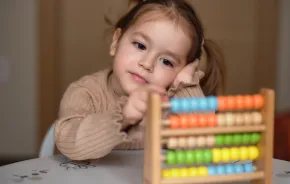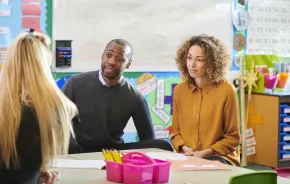
Parents at Seattle’s Evergreen School couldn’t believe it. Their kids were, on their own, asking for “a mindful moment in my room” when things got tense at home. It was an unexpected benefit of the school’s new mindfulness program, says Pamela Atteberry, a licensed social worker and the coordinator of student services at The Evergreen School.
“Kids were asking for Tibetan singing bowls [a traditional meditation tool] from Santa Claus,” she says. “They navigated to these ideas pretty darn quickly.”
The private school, which has classes for preschool through eighth-grade students, already offered a social emotional learning (SEL) program. Adding a mindfulness program would, administrators hoped, cement the skills developed by SEL.
“Our aim was to help integrate and enhance the social and emotional skills that we were already teaching,” says Atteberry.
The Evergreen School isn’t alone. There is currently no systems-wide number available for how many local schools are adding mindfulness programs to their SEL programs, but many are giving it a shot. To name a few: Lake Washington Girls Middle School, TOPS K-8 School and Thurgood Marshall Elementary School have all added mindfulness programs to their curricula within the past four years.
But do these programs work? That’s the question behind a new study led by University of Washington researcher Kevin King, Ph.D., for which initial findings will be posted this fall. In the meantime, local schools are already reporting on-the-ground shifts. Here are three of them.
The Evergreen School
The Evergreen School began teaching mindfulness in 2013. First, teachers and other school faculty learned mindfulness using Cultivating Awareness and Resilience in Education, or CARE for Teachers, a mindfulness training program for teachers designed by the Garrison Institute.
“Teachers learned different aspects of showing compassion for themselves and becoming attuned to the present moment throughout the school day,” says Atteberry. An example of one exercise: During a coffee break, walk and move while focusing on breathing and paying attention to your surroundings.
We’re looking to teach the students how to pause between the stimulus and the response.
Two years after Evergreen faculty began practicing mindfulness, students and parents joined in. Evergreen uses a broad definition of mindfulness as developed by well-known mindfulness expert Jon Kabat-Zinn: present moment awareness without judgment.
Rather than focusing on meditation, for example, the school’s mindfulness program promotes specific mindfulness skills. This might be a one-minute “mindful moment” that increases to five minutes. Or perhaps it’s meditating while walking, eating, writing or drawing.
“If your body is more in tune with itself thanks to practicing mindfulness tools on a regular basis, you can use those tools when you’re flooded [with] emotions before you cognitively solve the problem,” says Atteberry. “We’re looking to teach the students how to pause between the stimulus and the response.”

Roosevelt High School
After two students committed suicide within two years, Roosevelt High School administrators knew something had to change. In 2016, the northeast Seattle school implemented a 20-minute weekly, schoolwide mindfulness program.
Every Thursday, teachers present themed lessons in class that include a mindfulness practice and a three- to five-minute guided sitting meditation. The goal: Teach students how to check in with themselves, particularly during moments of stress, worry and even boredom.
“As the program continues this school year, we’ll also ask students to notice where their attention is right now. Are they focused on worry, creating drama, joy or gratitude? If students are stuck on worry, can they shift to gratitude, breathing or staying with the sensation of worry without adding a big story and see if worry will pass?” says Ann Hollar, facilitator and program creator. Hollar is a certified Mindful Schools instructor from the University of Washington’s Center for Child and Family Well-Being (CCFW).
We’re going to teach ourselves how to be kind to ourselves ... Think about it: How many times a day do you criticize yourself?
The students seem to like it, too. They most liked the informal breathing practices and short guided sitting meditations, according to a survey filled out by 95 students. They also reported using these practices before exams, when they felt overwhelmed or mentally stuck and when they experienced tough emotional situations.
“We’re going to teach ourselves how to be kind to ourselves,” one senior explained in a video produced by students while taking the program. “That might sound simple, but it’s deeper than that ... Think about it: How many times a day do you criticize yourself?”
Quil Ceda Tulalip Elementary School
For 45 minutes every week last spring, the teachers at Quil Ceda Tulalip Elementary School in Marysville took time out for themselves. They were part of a six-week mindfulness program created with the help of the CCFW. The goal of the program was to reduce the stress of teachers and, in doing so, improve their ability to teach.
The teachers shared what they’d learned with students, including adding guided breathing techniques to the weekly all-school assembly and bringing the skills to class.
“During tense classroom moments, teachers articulated how they were calming themselves,” says Robyn Long, the program administrator and CCFW staff member. “They’d say, ‘I’m a little frustrated because the classroom is chaotic, so I’m going to step back and take a few deep breaths.’”
Students noticed. “They began to behave this way, too,” says Long. “They started taking breathing breaks and identifying their emotions in their bodies when they were feeling tense.”
During tense classroom moments, teachers articulated how they were calming themselves.
Long and her team asked teachers to answer a written questionnaire before and after the program. “We found statistically significant improvements in self-kindness, common humanity, mindfulness and overall self-compassion,” says Long.
Teachers also reported that increased self-compassion made them feel more relaxed and more compassionate toward colleagues and students. They saw it in their students, too.
“My students are only 6 and 7,” one teacher wrote. “Once I gave them the reminder [to ‘use your strategies’], they were able to stop and breathe. It has turned a long period of breathing with them into one sentence to get them to turn around.”
Top mindfulness apps for kids
|











